Characterization of Dielectric Oil with a Low-Cost CMOS Imaging Sensor and a New Electric Permittivity Matrix Using the 3D Cell Method
Abstract
:1. Introduction
2. Distribution of and in the Dielectric Strength Test
2.1. New Constitutive Matrix . Discrete Constitutive Equations of Transformer Oil in the Finite Formulation
2.2. Maxwell’s Laws in Finite Formulation Applied to Transformer Oil
- (a)
- Gauss’s law for the magnetic field, Equation (6)where D is the volume–face incidence matrix of the primal mesh, which is equivalent to the standard divergence operator. The magnitude represents a vector with all the magnetic fluxes associated with the four faces of the primal mesh tetrahedron if i = 1:4, as shown in Figure 1.
- (b)
- Faraday’s law of induction, Equation (7)where C is the face–edge incidence matrix of the primal mesh, which is equivalent to the standard rotational operator. is a vector of potential differences extended to all edges of the primal mesh and t is time.
- (c)
- Generalized Ampere’s law, Equation (8)where is the face–edge incidence matrix in the dual mesh, the vector is a vector of magnetomotive force associated with all the edges of the dual mesh, is a vector of electric currents extended to all planes of the dual mesh and, finally, is the electric flux due to the polarization of the dielectric associated with the faces of the dual mesh.
- (d)
- Gauss’s law of the electric field, Equation (9)where is the incidence matrix of the volumes–faces of the dual mesh and is the charge contained in each dual volume.
2.3. Maxwell’ Laws and Constitutive Equations
2.4. Kelvin Polarization Forces in Dielectric Materials
3. The Low-Cost 8 MP CMOS Imaging Sensor
3.1. Camera Features
3.2. Camera Triggering with Raspberry Pi
4. Numerical Results of the Simulations in CM with vs. FEM
4.1. Validation of the Numerical Simulations
4.1.1. Results of Experiment E1
4.1.2. Results of Experiment E2
4.1.3. Results of Experiment E3
4.2. Metrics of Numerical Experiments
5. Experimental Setup of Oil Testing Device
5.1. Procedure for Dielectric Strength Test and Kinematic Viscosity of Oil
5.2. Performed Experiments
5.3. Experimental Measurement of the Dynamic Viscosity of Oil
5.3.1. Theoretical Basis
5.3.2. Experimental Results for a Rate of Increase of 0.5 kV/s
5.3.3. Comparison of the Kinematic Viscosity with the Proposed Method and Manufacturer’s Data
6. Conclusions
7. Annex
Author Contributions
Funding
Institutional Review Board Statement
Informed Consent Statement
Acknowledgments
Conflicts of Interest
Nomenclature
| Symbol | Name | Unit |
| Angular frequency | rad/s | |
| Di | Bubble diameter | m |
| Bubble surface tension | N/m | |
| R | Bubble radius | m |
| τe | Charge-relaxation time | s |
| N | Data number | - |
| Xi | Data obtained | - |
| Δρ | Density difference between oil and gas | kg/m3 |
| VDBV | Dielectric breakdown voltage | V |
| Displacement electric current | A | |
| l | Domain characteristic length | m |
| Dual faces | m2 | |
| Electric charge in dual volumes | C | |
| σ | Electric conductivity | S/m |
| Mσ | Electric conductivity constitutive matrix | S |
| Conductive electric current | A | |
| Electric field strength | V/C | |
| Electric flow | C | |
| Electric flow in vacuum | C | |
| Electrical permittivity constitutive matrix | F | |
| ε0 | Electrical permittivity in vacuum | F/m |
| Mε0 | Electrical permittivity in vacuum constitutive matrix | F |
| ε | Electrical permittivity of the medium | F/m |
| U | Electric potential difference | V |
| Frequency | Hz | |
| g | Gravity acceleration | m/s2 |
| Incidence vector of relative cohomology between oil volume and electrode surface. | - | |
| C, | Incidence matrix faces–edges in primal and dual mesh | - |
| Incidence matrix faces–volumes in primal and dual mesh | - | |
| G | Incidence matrix edges–nodes of primal mesh | - |
| j | Imaginary unit | - |
| Kelvin polarization force | N | |
| Φ | Magnetic flow | Wb |
| Magnetomotive force | A | |
| Oil density | kg/m3 | |
| Oil dynamic viscosity | Ns/m2 | |
| Oil height | m | |
| Oil relative permittivity | - | |
| Polarization electric flow | C | |
| Polarization electrical permittivity constitutive matrix | F | |
| Reference data | - | |
| Reference data mean | ||
| εr | Relative electrical permittivity | - |
| φ | Scalar electric potential | V |
| r | Spherical particle radius | m |
| τ | Sinusoidal signal period | s |
| c | Speed of light | m/s |
| T | Temperature | °C |
| VT | Terminal velocity of the bubble in the oil | m/s |
| ν | Tetrahedron volume | m3 |
| τem | Time electromagnetic constant | s |
| τm | Time magnetic constant | s |
| Total current | A | |
| Volumetric density current | A/m2 | |
| Volumetric density of conductive current | A/m2 |
References
- Islam, M.; Lee, G.; Hettiwatte, S.N. A review of condition monitoring techniques and diagnostic tests for lifetime estimation of power transformers. Electr. Eng. 2017, 100, 581–605. [Google Scholar] [CrossRef]
- Mahanta, D.K.; Laskar, S. Electrical insulating liquid: A review. J. Adv. Dielectr. 2017, 7, 1730001. [Google Scholar] [CrossRef] [Green Version]
- IEEE. Guide for Acceptance and Maintenance of Insulating Mineral Oil in Electrical Equipment; IEEE: Piscataway, NJ, USA, 2015. [Google Scholar]
- CIGRE. Life Management Techniques for Power Transformers; CIGRE: Paris, France, 2003; Volume 49. [Google Scholar]
- Kuffel, E.; Zaengl, W.; Kuffel, J. High Voltage Engineering Fundamentals; Elsevier: Amsterdam, The Netherlands, 2000; ISBN 0750636343. [Google Scholar]
- Radjenovic, B.; Klas, M.; Bojarov, A.; Matejcik, S. The breakdown mechanisms in electrical discharges: The role of the field emission effect in direct current discharges in microgaps. Acta Phys. Slovaca 2014, 63, 105–205. [Google Scholar] [CrossRef]
- Tonti, E. Why starting from diferential equations for computational physics? J. Comput. Phys. 2014, 257, 12601290. [Google Scholar] [CrossRef]
- Tonti, E. The Mathematical Structure of Classical and Relativistic Physics; Birkhäuser: Basel, Switzerland, 2013; p. 17. ISBN 9781461474210. [Google Scholar]
- Tonti, E. A Direct Discrete Formulation of Field Laws: The Cell Method. CMES Comput. Model. Eng. Sci. 2001, 2, 237–258. [Google Scholar]
- Marrone, M. Computational Aspects of the Cell Method in Electrodynamics. Prog. Electromagn. Res. 2001, 32, 317–356. [Google Scholar] [CrossRef] [Green Version]
- Codecasa, L.; Trevisan, F. Constitutive equations for discrete electromagnetic problems over polyhedral grids. J. Comput. Phys. 2007, 225, 1894–1918. [Google Scholar] [CrossRef]
- Bullo, M.; Dughiero, F.; Guarnieri, M.; Tittonel, E. Isotropic and Anisotropic Electrostatic Field Computation by Means of the Cell Method. IEEE Trans. Magn. 2004, 40, 1013–1016. [Google Scholar] [CrossRef]
- Bettini, P.; Trevisan, F. Electrostatic analysis for plane problems with finite formulation. IEEE Trans. Magn. 2003, 39, 1127–1130. [Google Scholar] [CrossRef]
- Bettini, P.; Specogna, R.; Trevisan, F. Electroquasistatic Analysis of the Gas Insulated Line for the ITER Neutral Beam Injector. IEEE Trans. Magn. 2009, 45, 996–999. [Google Scholar] [CrossRef]
- Monzon-Verona, J.M.; Santana-Martin, F.J.; Garcia-Alonso, S.; Montiel-Nelson, J.A. Electro-quasistatic analysis of an electro-static induction micromotor using the cell method. Sensors 2010, 10, 9102–9117. [Google Scholar] [CrossRef] [PubMed] [Green Version]
- Specogna, R.; Trevisan, F. Discrete constitutive equations in A-χ geometric eddy-current formulation. IEEE Trans. Magn. 2005, 41, 1259–1263. [Google Scholar] [CrossRef]
- IEC 60156 Insulating Liquids Determination of the Breakdown Voltage at Power Frequency. Test Method. Available online: https://webstore.iec.ch/publication/28297IEC (accessed on 23 September 2021).
- Haus, H.A.; Melcher, J.R. Electromagnetic Fields and Energy; (Massachusetts Institute of Technology: MIT OpenCourseWare). License: Creative Commons Attribution—NonCommercial—Share Alike; Prentice-Hall: Englewood Cliffs, NJ, USA, 1989; ISBN 9780132490207. Available online: https://ocw.mit.edu/resources/res-6-001-electromagnetic-fields-and-energy-spring-2008/chapter-3/03.pdf (accessed on 23 September 2021).
- Baz-Rodríguez, S.; Aguilar-Corona, A.; Soria, A. Rising velocity for single bubbles in Pure Liquids. Rev. Mex. Ing. Quím. 2012, 11, 269–278. [Google Scholar]
- Pagnutti, M.; Ryan, R.E.; Cazenavette, G.; Gold, M.; Harlan, R.; Leggett, E.; Pagnutti, J. Laying the foundation to use Raspberry Pi 3 V2 camera module imagery for scientific and engineering purposes. J. Electron. Imaging 2017, 26, 013014. [Google Scholar] [CrossRef] [Green Version]
- Riba, J.-R.; Gómez-Pau, Á.; Moreno-Eguilaz, M. Experimental Study of Visual Corona under Aeronautic Pressure Conditions Using Low-Cost Imaging Sensors. Sensors 2020, 20, 411. [Google Scholar] [CrossRef] [PubMed] [Green Version]
- Eichhorn, G.N.; Bowman, A.; Haigh, S.K.; Stanier, S. Low-cost digital image correlation and strain measurement for geotechnical applications. Strain 2020, 56, e12348. [Google Scholar] [CrossRef] [Green Version]
- Book: Electromagnetics and Applications (Staelin). Available online: https://phys.libretexts.org/Bookshelves/Electricity_and_Magnetism/Book%3A_Electromagnetics_and_Applications_(Staelin) (accessed on 23 September 2021).
- Schmid, S.; Hierold, C.; Boisen, A. Modeling the Kelvin polarization force actuation of micro- and nanomechanical systems. J. Appl. Phys. 2010, 107, 54510. [Google Scholar] [CrossRef] [Green Version]
- Sha, Y.; Zhou, Y.; Nie, D.; Wu, Z.; Deng, J. A study on electric conduction of transformer oil. IEEE Trans. Dielectr. Electr. Insul. 2014, 21, 1061–1069. [Google Scholar] [CrossRef]
- Li, H.; Zhong, L.; Yu, Q.; Mori, S.; Yamada, S. The resistivity of oil and oil-impregnated pressboard varies with temperature and electric field strength. IEEE Trans. Dielectr. Electr. Insul. 2014, 21, 1851–1856. [Google Scholar] [CrossRef]
- Taslak, E.; Arikan, O.; Kumru, C.F.; Kalenderli, O. Analyses of the insulating characteristics of mineral oil at operating conditions. Electr. Eng. 2017, 100, 321–331. [Google Scholar] [CrossRef]
- Woodson, H.H.; Melcher, J.R. Electromechanical Dynamics; John Wiley and Sons, Inc.: New York, NY, USA, 1968; Reprint Krieger Publishing Company: Malabar, FL, USA, 1990, 1985, ISBN 9780894644597 (v.1), 9780898748475 (v. 2), 9780898748482 (v. 3).18. [Google Scholar]
- Craig, A.; Coburna, A.M.; Smitha, B.; Gordon, S.; Logieaand, P.K. Radiometric and spectral comparison of inexpensive camera systems used for remote sensing. Int. J. Remote Sens. 2018, 39, 4869–4890. [Google Scholar] [CrossRef]
- Home—OpenCV. Available online: https://opencv.org (accessed on 23 September 2021).
- NumPy. Available online: https://numpy.org/ (accessed on 23 September 2021).
- Picamara. Available online: https://picamera.readthedocs.io/en/release-1.13/ (accessed on 23 September 2021).
- Portable, Extensible Toolkit for Scientic Computation. Available online: http://www.mcs.anl.gov/petsc (accessed on 23 September 2021).
- Dular, P.; Geuzaine, C. GetDP Reference Manual: The Documentation for GetDP, a General Environment for the Treatment of Discrete Problems. Available online: http://getdp.info (accessed on 23 September 2021).
- Geuzaine, G.; Remacle, J.-F. Gmsh: A three-dimensional finite element mesh generator with built-in pre- and post-processing facilities. Int. J. Numer. Methods Eng. 2009, 79, 13091331. [Google Scholar] [CrossRef]
- Martínez, E.R. Errores frecuentes en la interpretación del coeficiente de determinación lineal. Anu. Jurid. Econ. Escur. 2005, 38, 317–331. [Google Scholar]
- Hyndman, R.; Koehler, A.B. Another look at measures of forecast accuracy. Int. J. Forecast. 2006, 22, 679–688. [Google Scholar] [CrossRef] [Green Version]
- Sanabria, J.; García, J.; Lhomme, J.P. Calibración y Validación de Modelos de Pronóstico de Heladas en el Valle del Mantaro. Master’s Thesis, Universidad Nacional Agraria La Molina, La Molina, Peru, 2006. [Google Scholar]
- ASTM D445. Standard Test Method for Kinematic Viscosity of Transparent and Opaque Liquids (and Calculation of Dynamic Viscosity); ASTM Volume 05.01 Petroleum Products, Liquid Fuels, and Lubricants (II): C1234—D4176; ASTM: West Conshohocken, PA, USA, 2019. [Google Scholar]
- ASTM. ASTM D4052. Standard Test Method for Density, Relative Density, and API Gravity of Liquids by Digital Density Meter; ASTM Volume 05.01 Petroleum Products, Liquid Fuels, and Lubricants (II): C1234—D4176; ASTM: West Conshohocken, PA, USA, 2018. [Google Scholar]
- ASTM. ASTM D92. Standard Test Method for Flash and Fire Points by Cleveland Open Cup Tester; ASTM Volume 05.01 Petroleum Products, Liquid Fuels, and Lubricants (II): C1234—D4176; ASTM: West Conshohocken, PA, USA, 2018. [Google Scholar]
- ASTM. ASTM D1533: Standard Test Method for Water in Insulating Liquids by Coulometric Karl Fischer Titration; ASTM Volume 10.03 Electrical Insulating Liquids and Gases; Electrical Protective Equipment; ASTM: West Conshohocken, PA, USA, 2020. [Google Scholar]
- ASTM. ASTM D1500—12 Standard Test Method for ASTM Color of Petroleum Products (ASTM Color Scale); ASTM Volume 05.01 Petroleum Products, Liquid Fuels, and Lubricants (II): C1234—D4176; ASTM: West Conshohocken, PA, USA, 2017. [Google Scholar]
- Norma UNE 60296:2012. Fluidos para Aplicaciones Electrotécnicas. Aceites Minerales Aislantes Nuevos para Transformadores y Aparamenta de Conexión; AENOR: Madrid, Spain, 2012. [Google Scholar]
- ImajeJ. Available online: https://imagej.net/Welcome (accessed on 23 September 2021).
- Aceites Dieléctricos. Available online: https://www.repsol.com/imagenes/global/es/af-catalogo-aceites-dielectricos_tcm13-48939.pdf (accessed on 23 September 2021).
- Stanciu, I. A new viscosity-temperature relationship for mineral oil SAE 10W. Analele Univ. Ovidius Constanta Ser. Chim. 2012, 23, 27–30. [Google Scholar] [CrossRef] [Green Version]
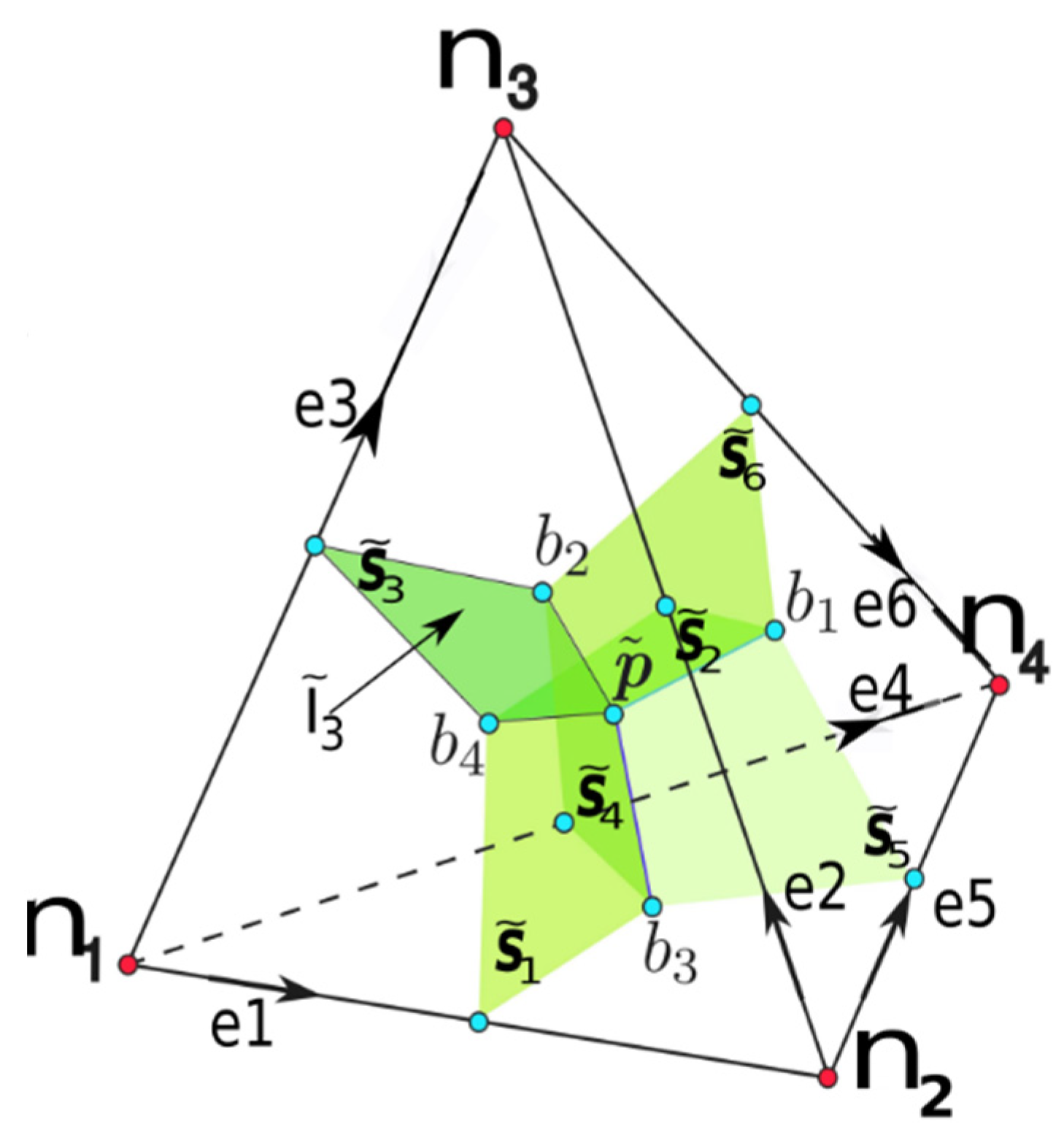
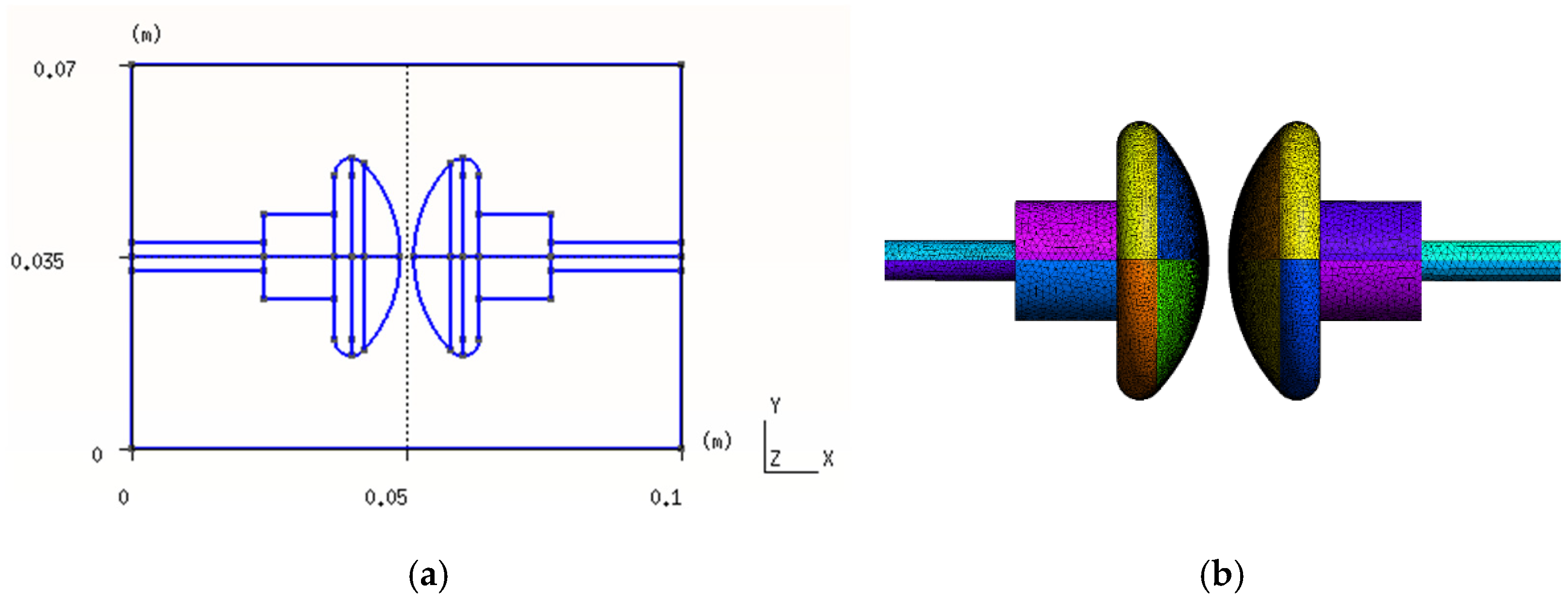

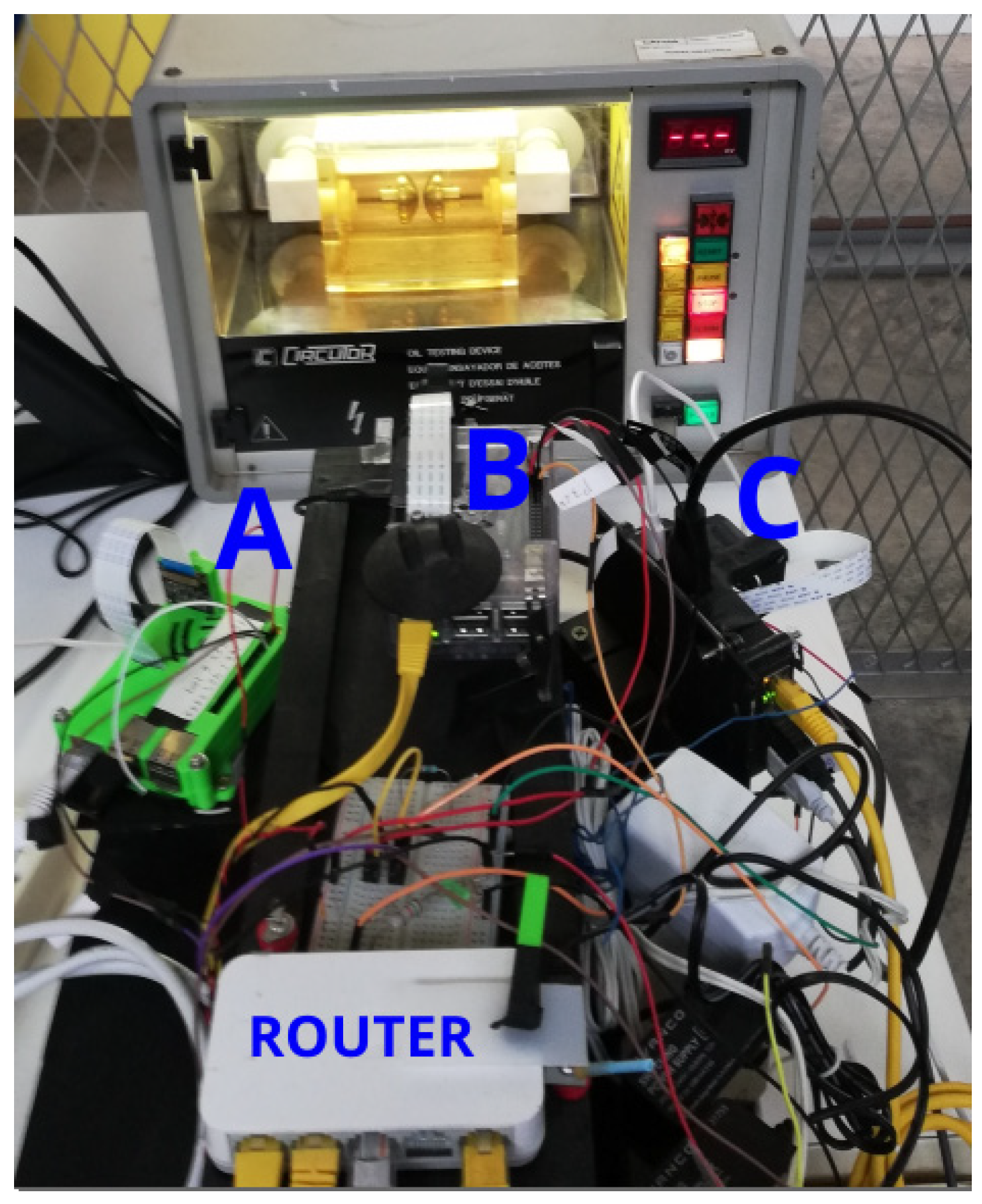


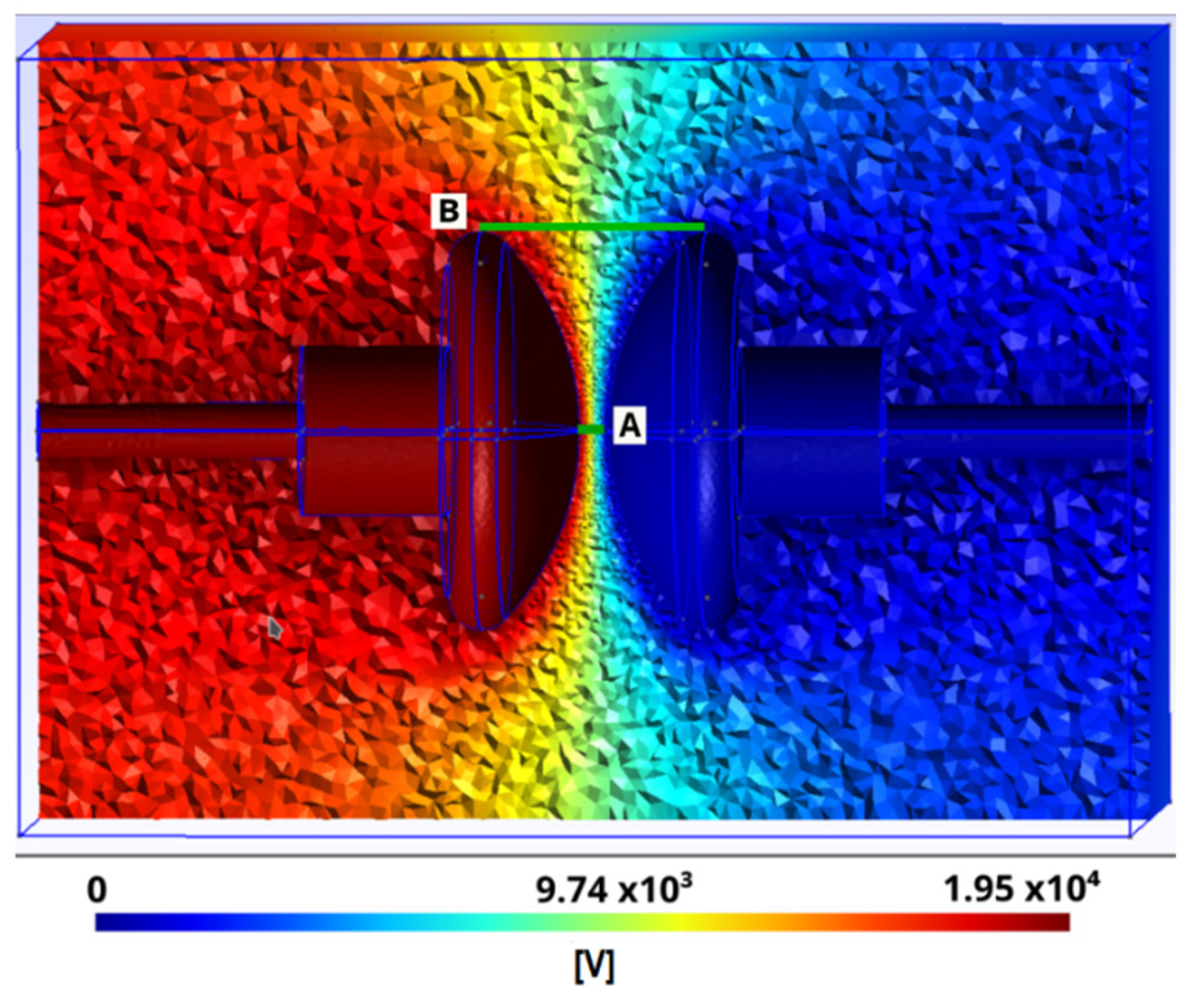
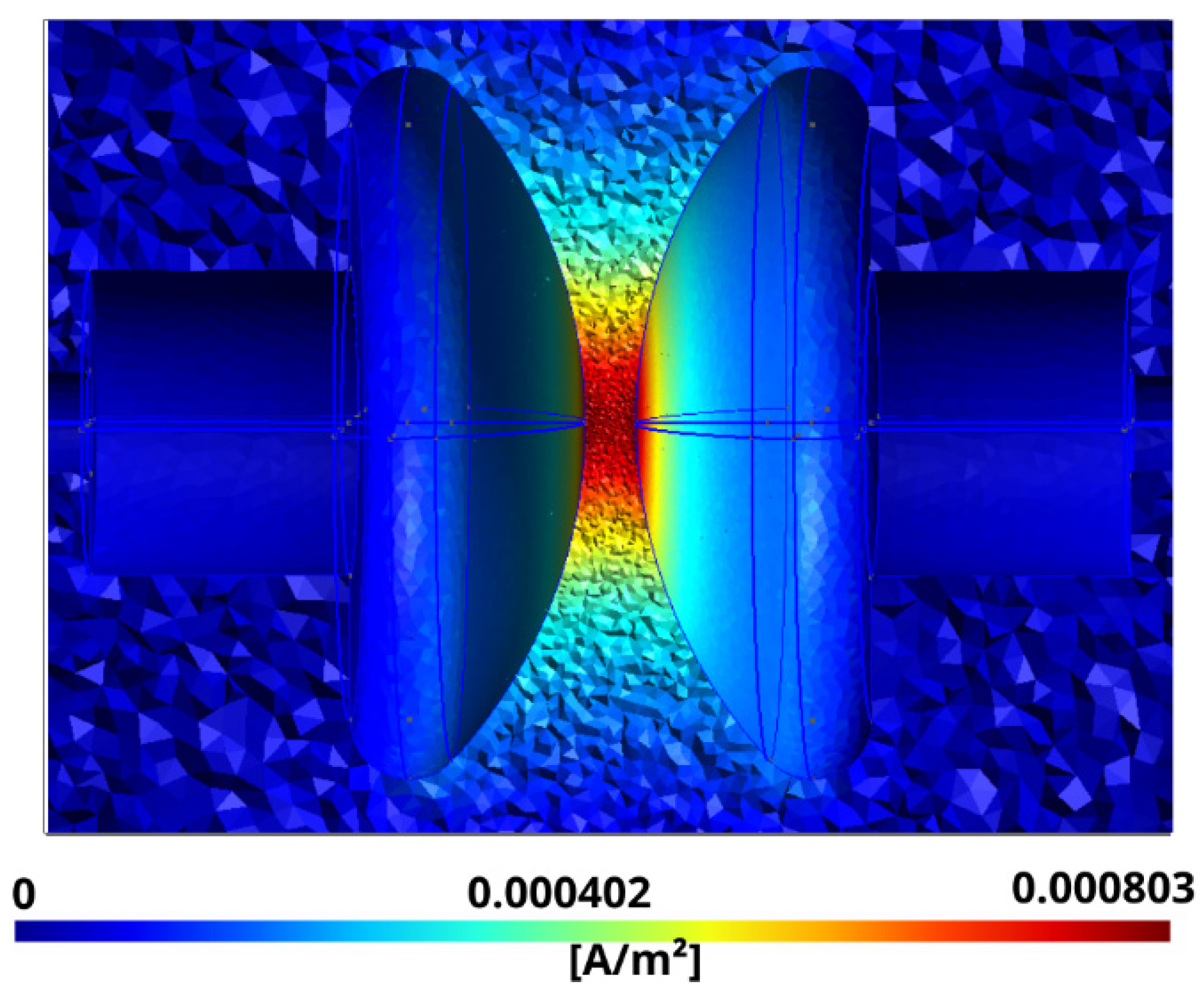
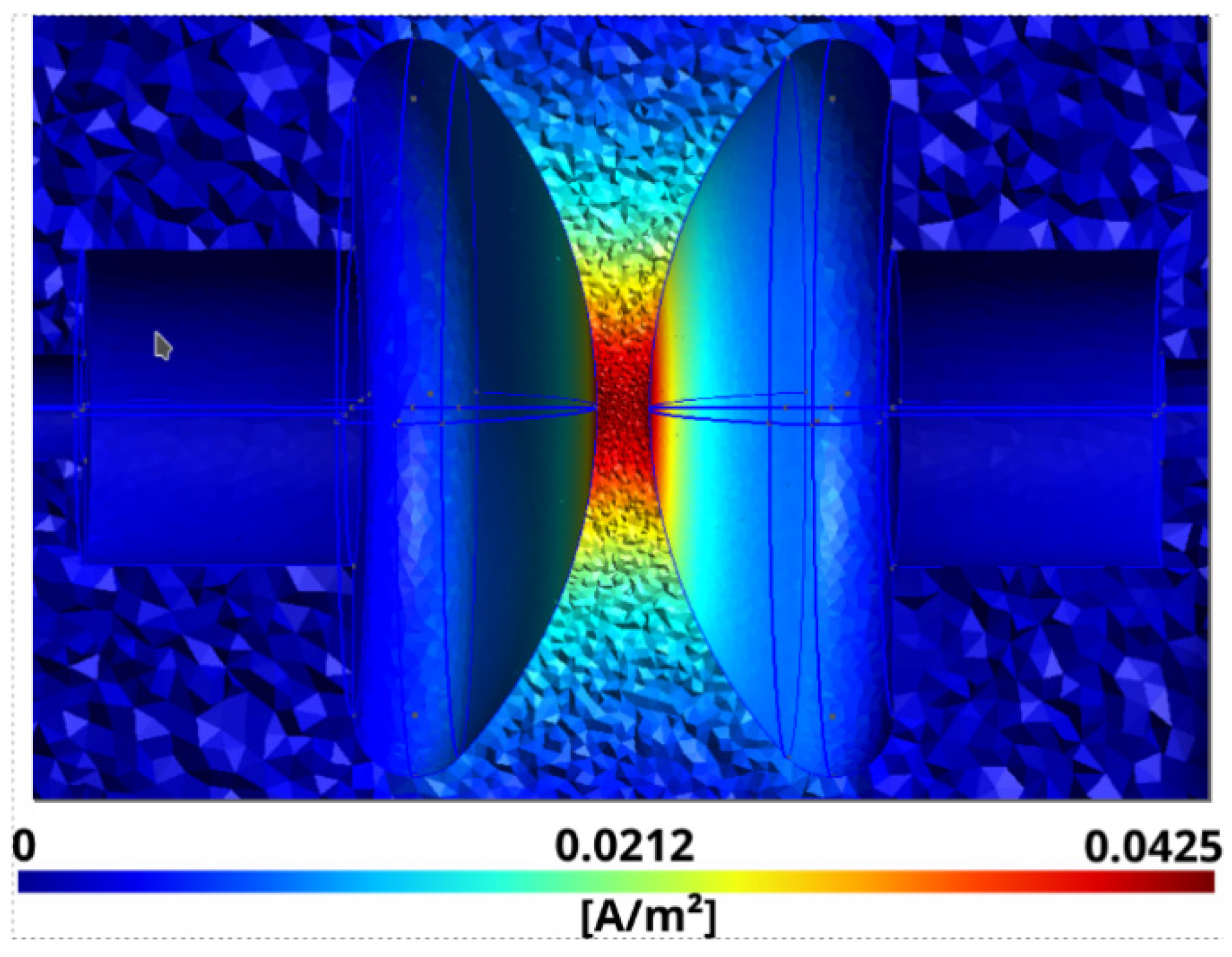
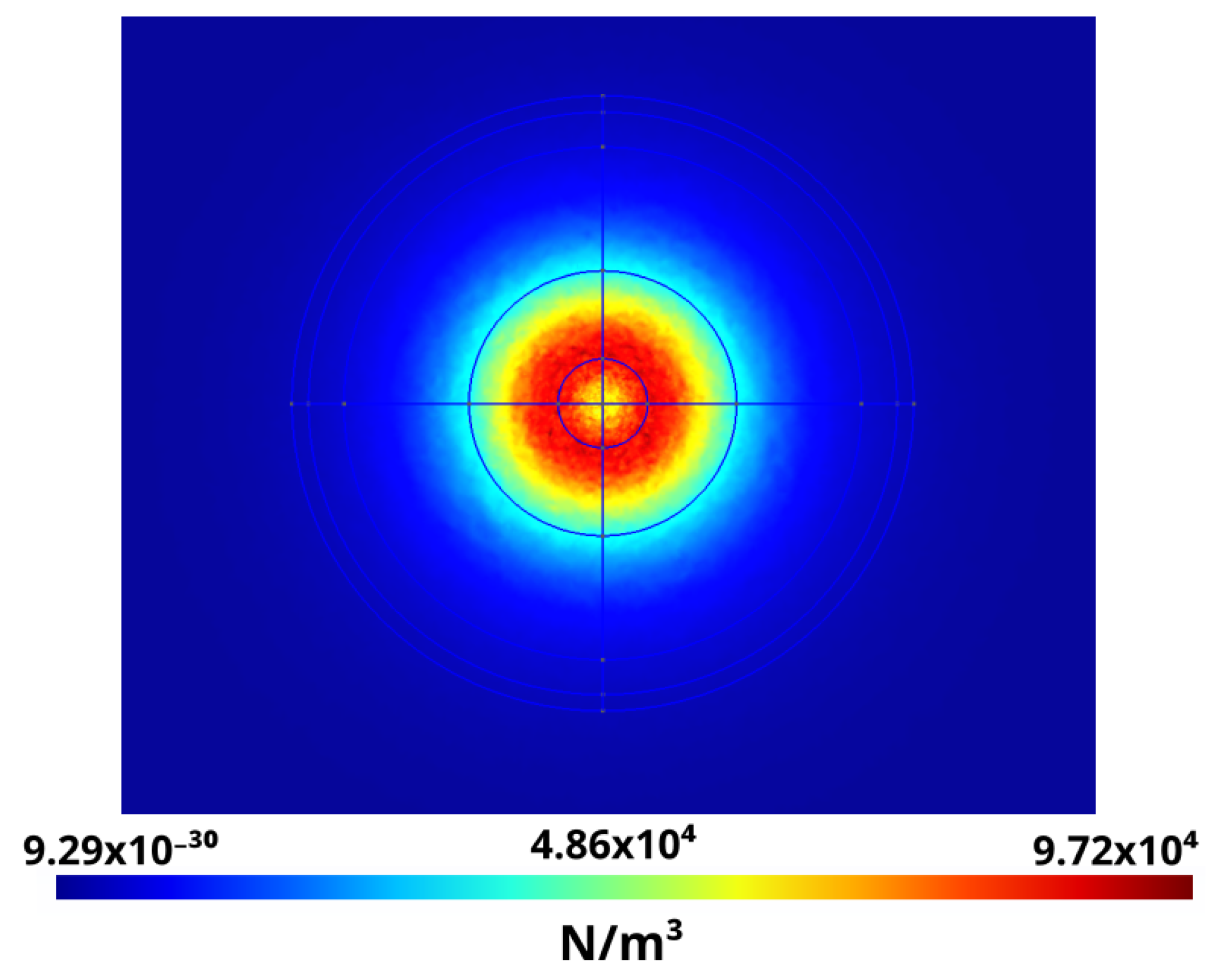


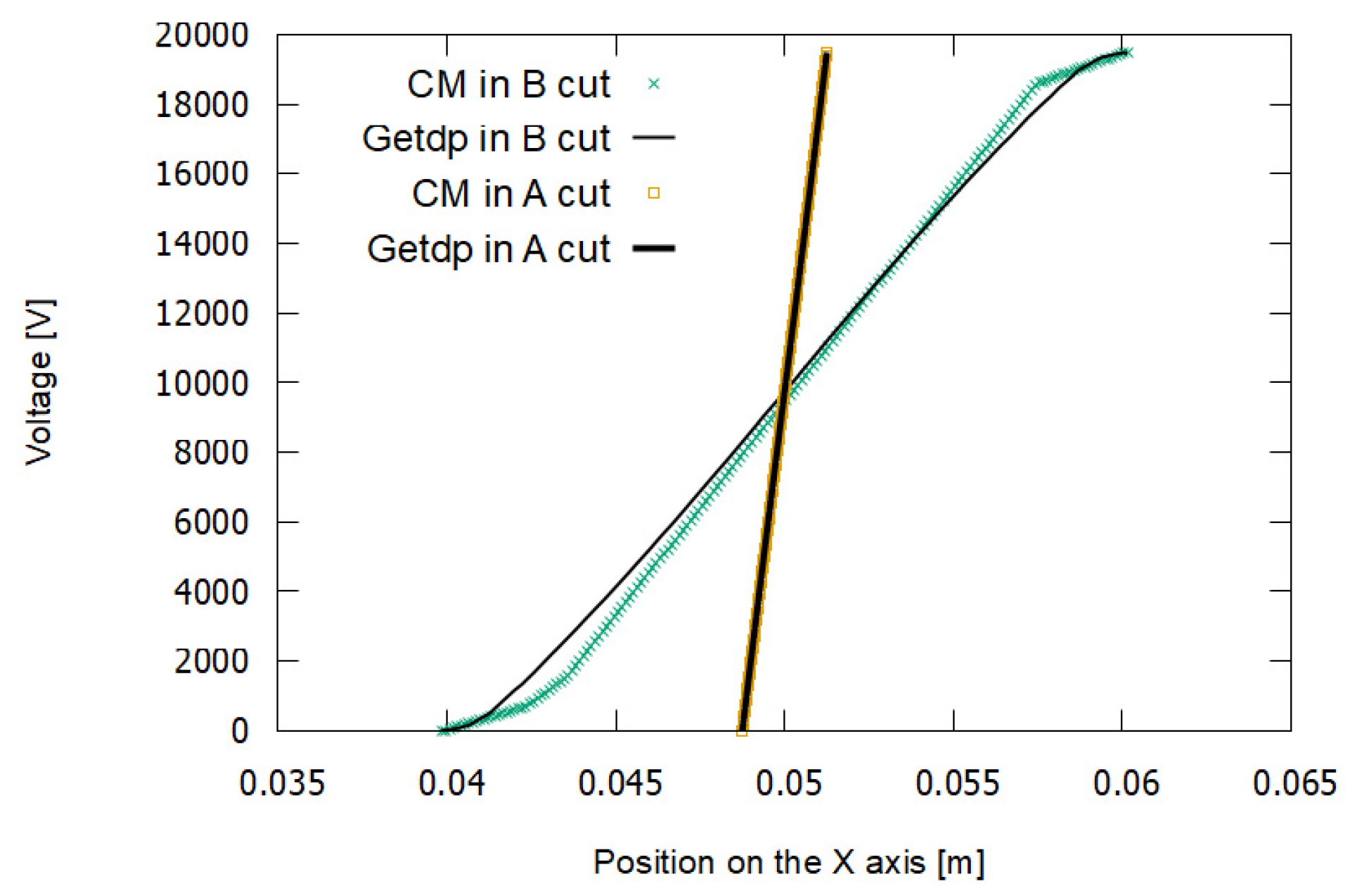
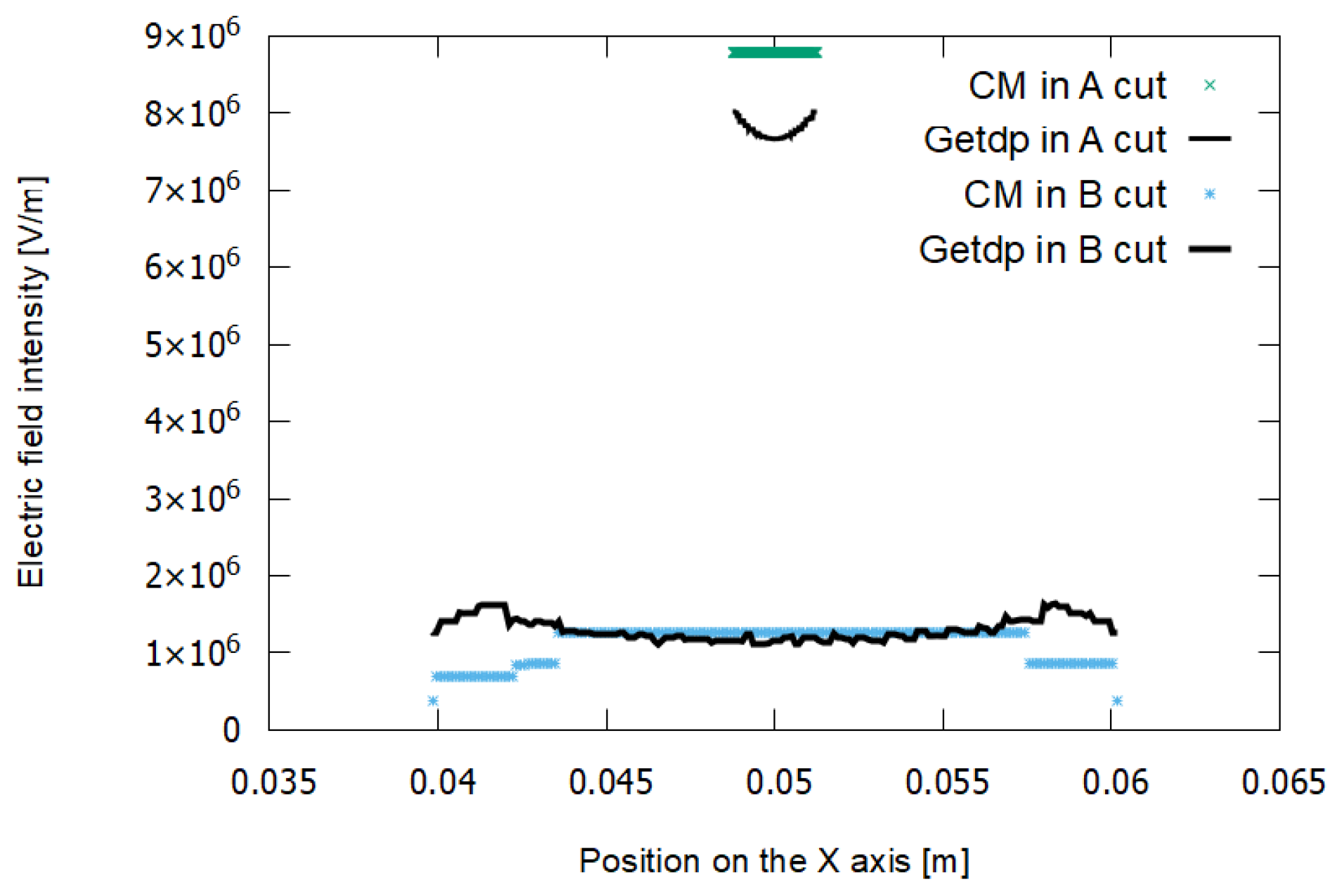
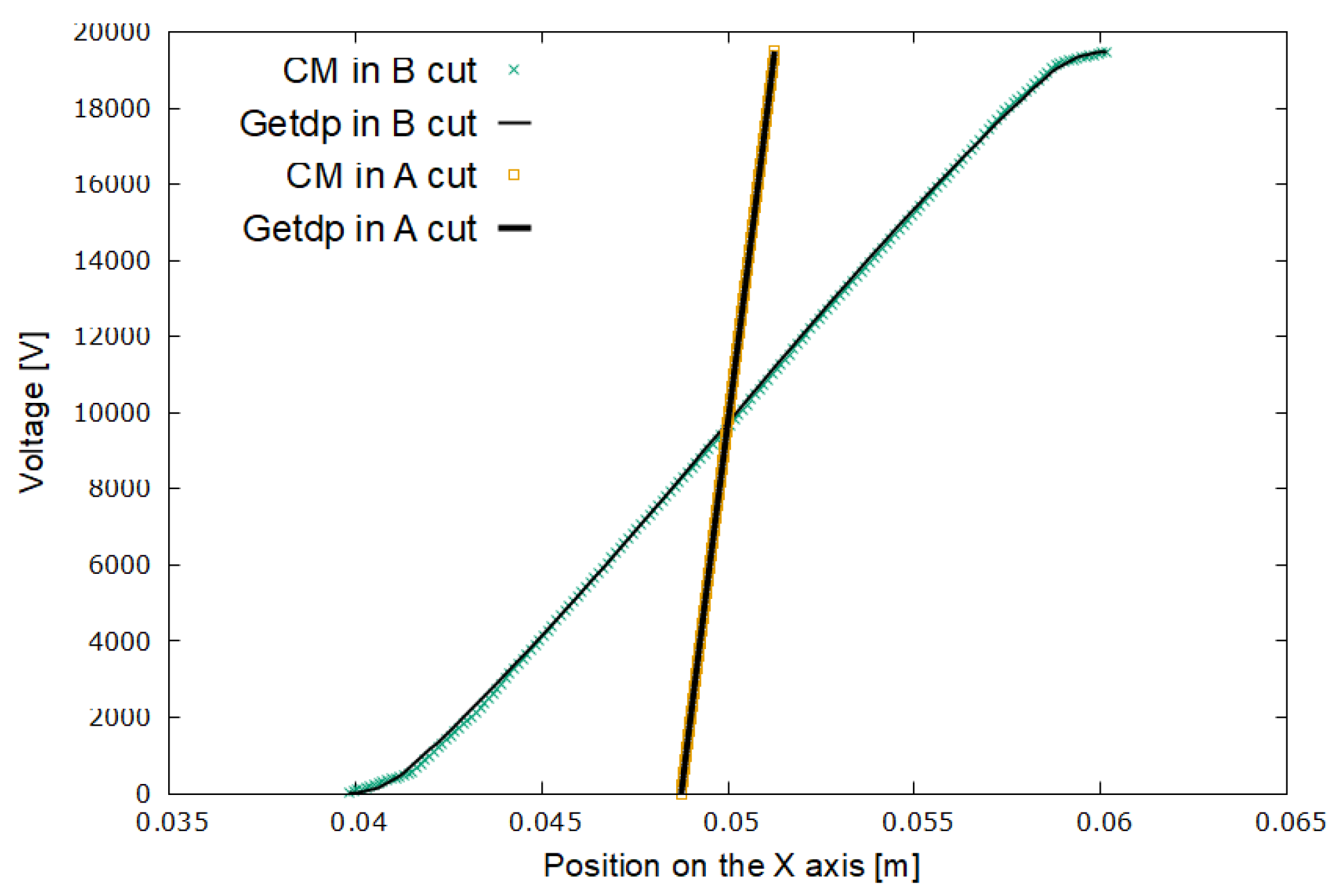
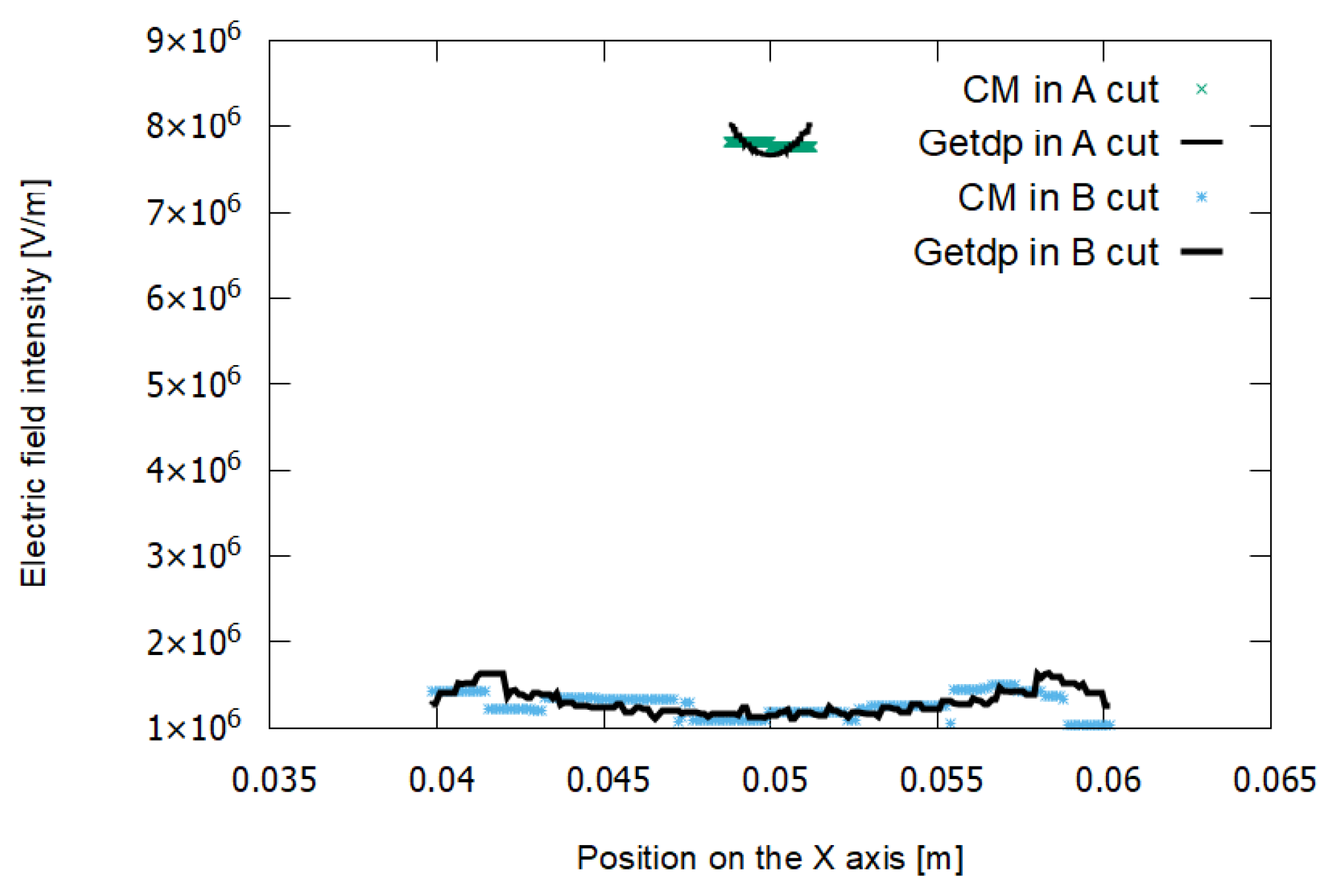

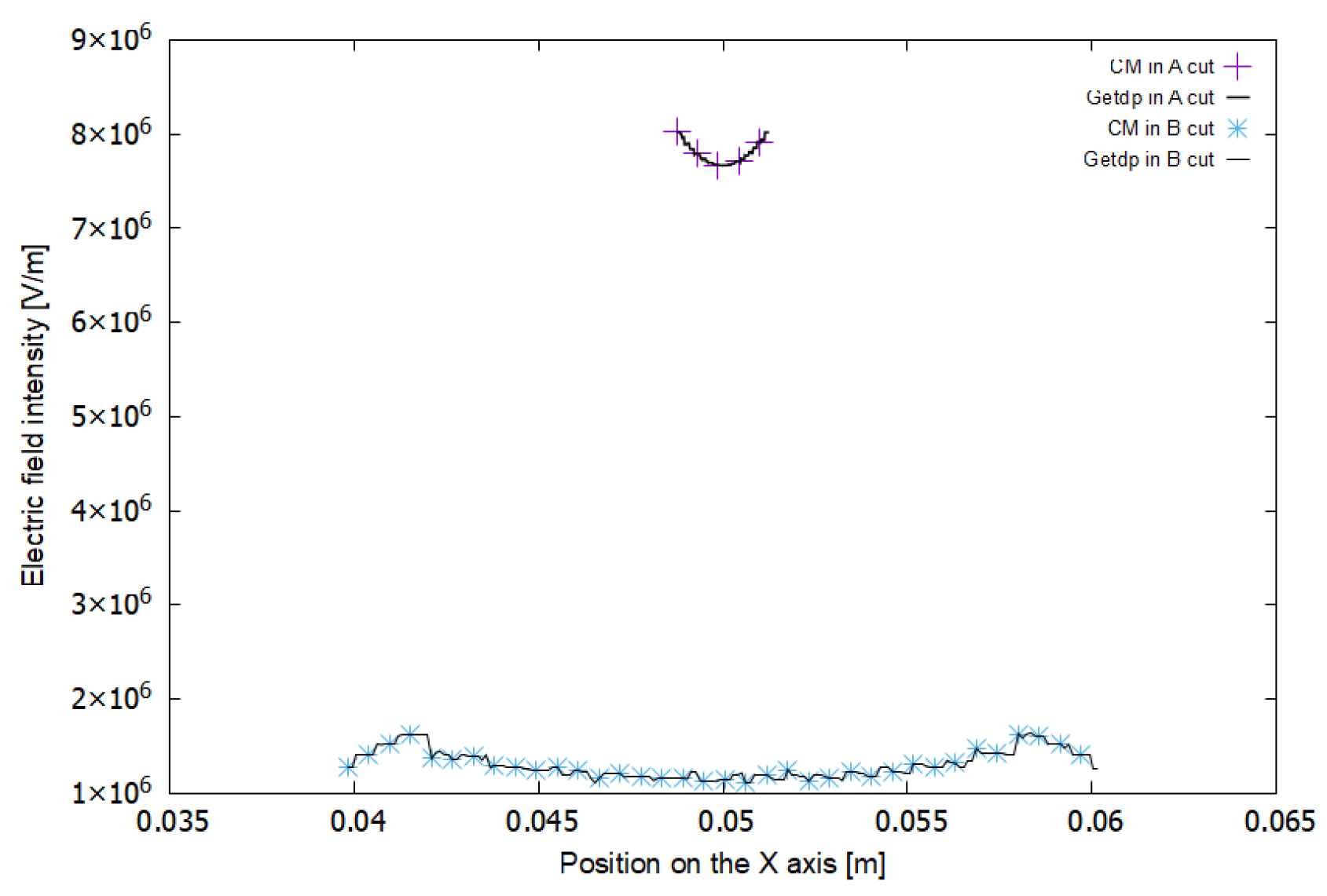

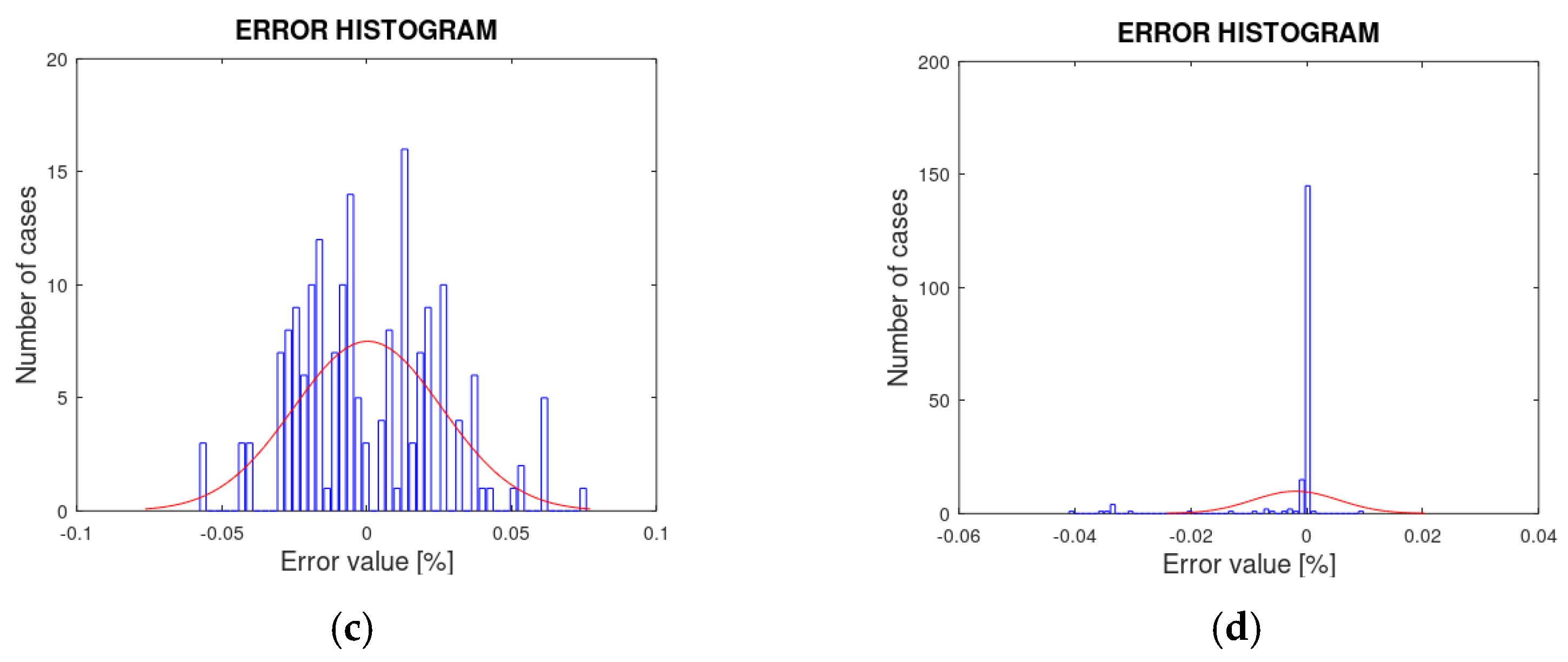
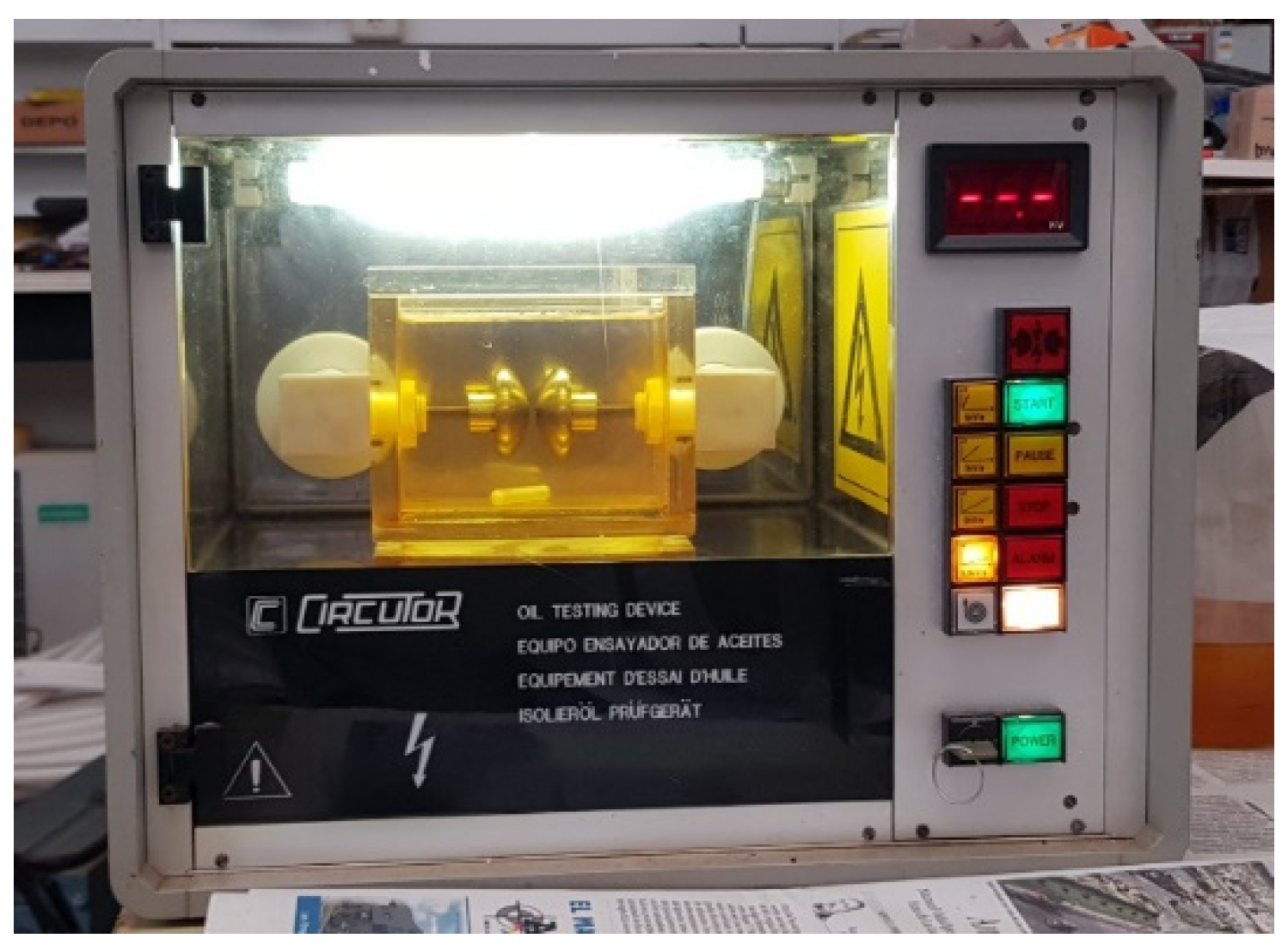
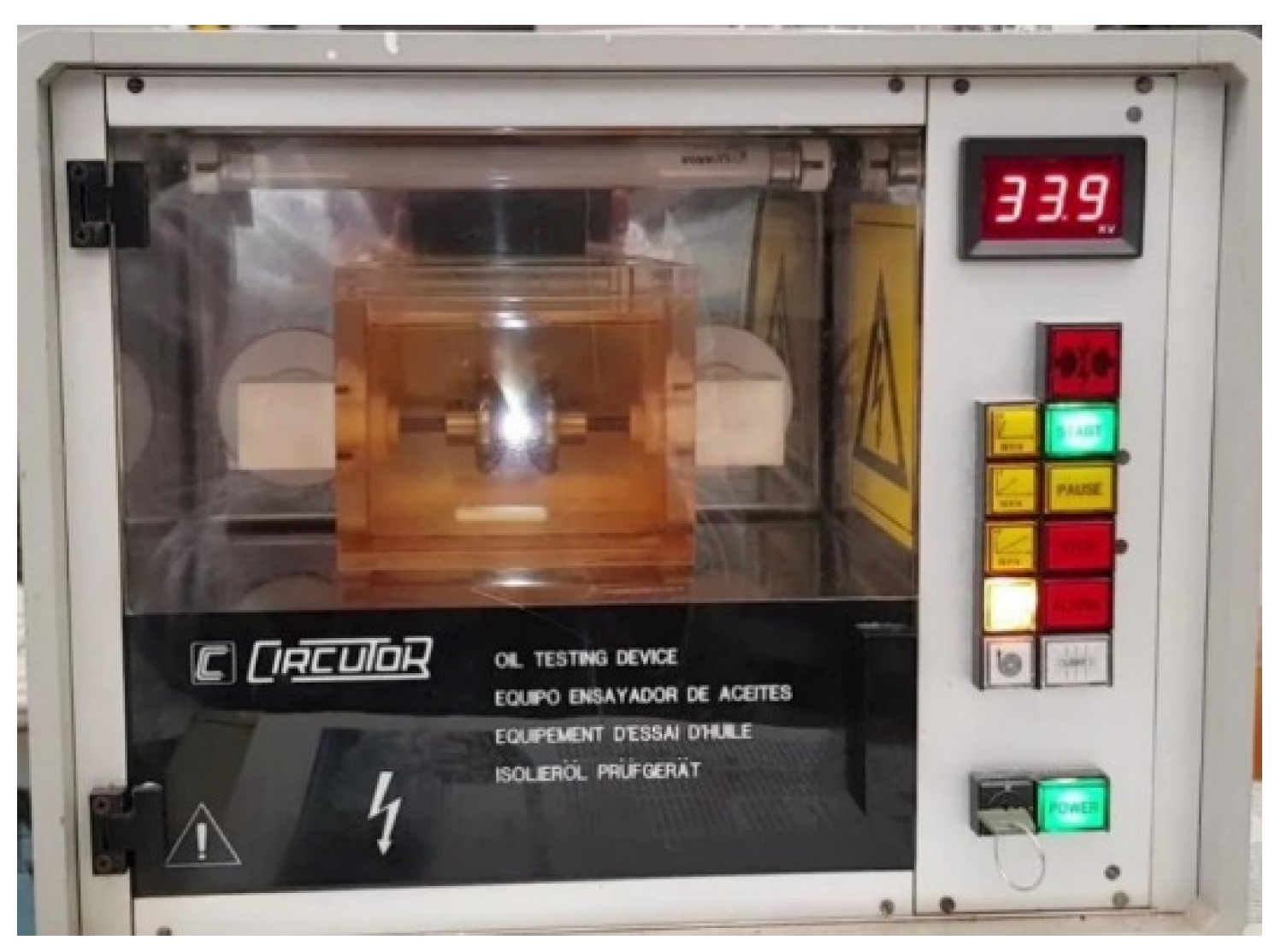
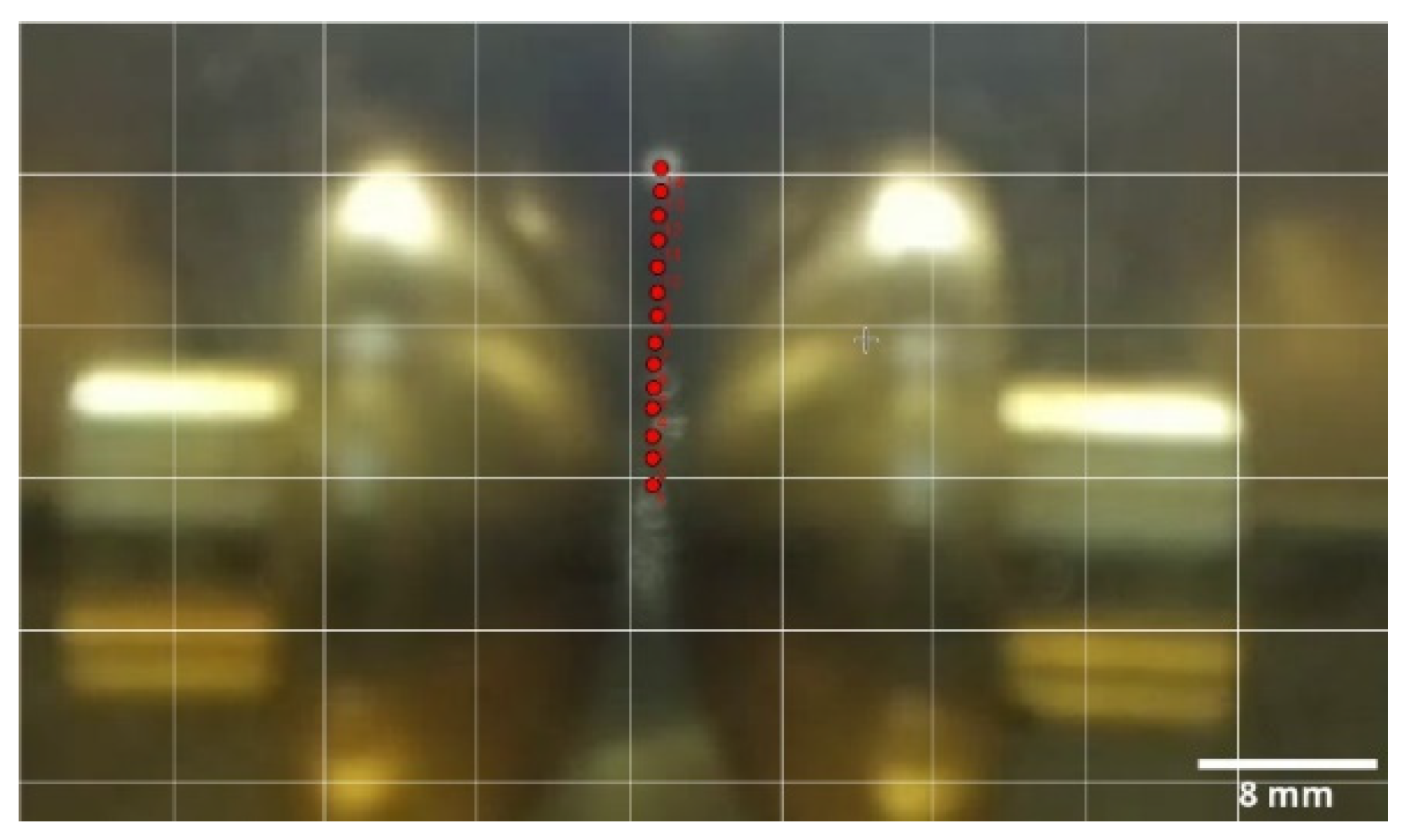
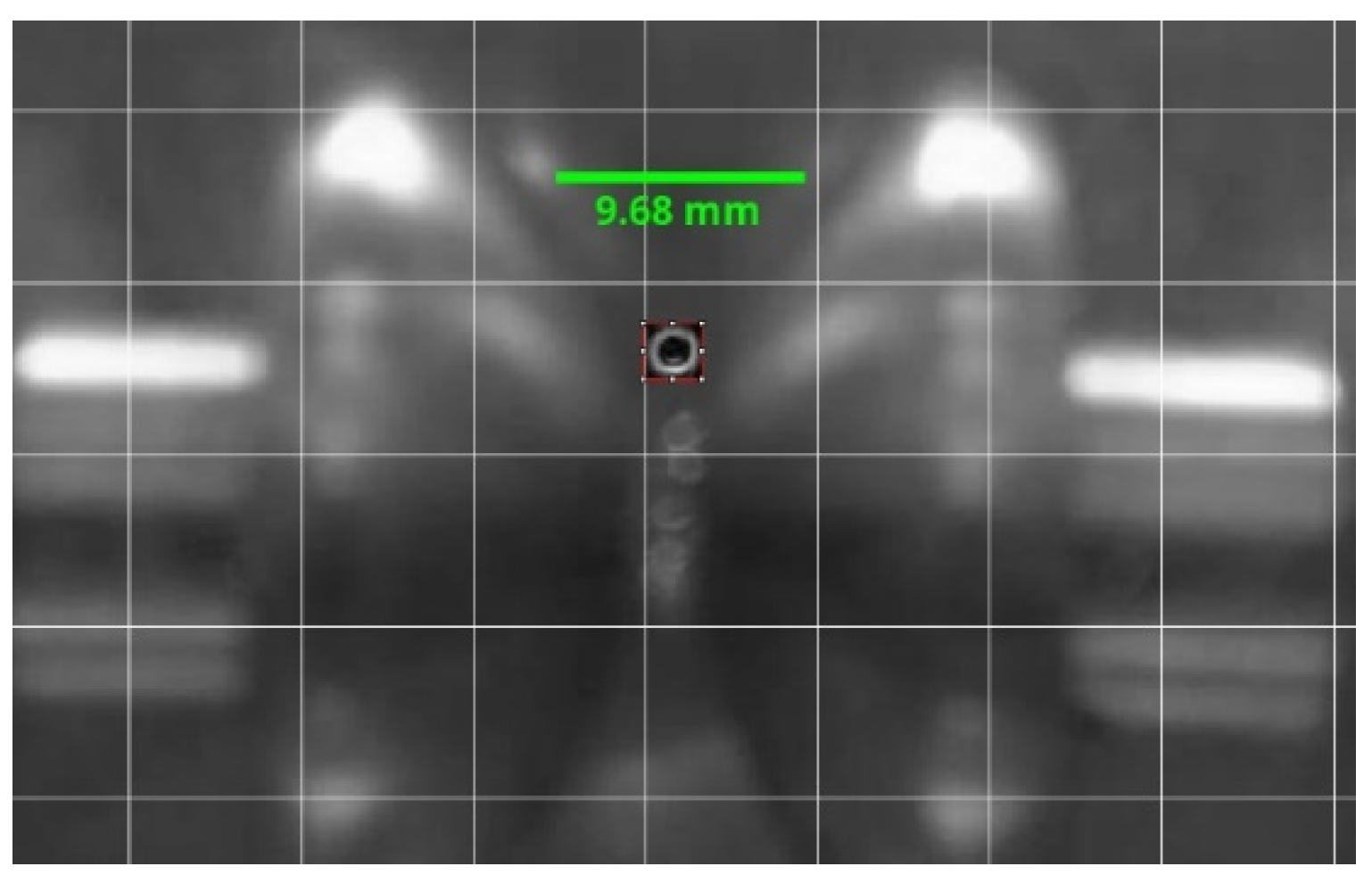

| Experiment | Nodes | Edges | Faces | Volumes | Conductivity [S/m] | Relative Permittivity | BDV [V] |
|---|---|---|---|---|---|---|---|
| E1 | 1175 | 6467 | 9687 | 4394 | 10−10 | 3.8 | 19,488 |
| E2 | 5889 | 34,737 | 54,142 | 25,293 | 10−10 | 3.8 | 19,488 |
| E3 | 487,435 | 3,362,385 | 5,665,540 | 2,790,589 | 10−10 | 3.8 | 19,488 |
| C1 | Numerical experiment E1-Cut A. Electric field. |
| C2 | Numerical experiment E1-Cut B. Electric field. |
| C3 | Numerical experiment E1-Cut A. Voltage. |
| C4 | Numerical experiment E1-Cut B. Voltage. |
| C5 | Numerical experiment E2-Cut A. Electric field. |
| C6 | Numerical experiment E2-Cut B. Electric field. |
| C7 | Numerical experiment E2-Cut A. Voltage. |
| C8 | Numerical experiment E2-Cut B. Voltage. |
| C9 | Numerical experiment E3-Cut A. Electric field. |
| C10 | Numerical experiment E3-Cut B. Electric field. |
| C11 | Numerical experiment E3-Cut A. Voltage. |
| C12 | Numerical experiment E3-Cut B. Voltage. |
| Comparison | C1 | C2 | C3 | C4 | C5 | C6 | References |
|---|---|---|---|---|---|---|---|
| R2 [0, +1] Optimum: +1 | 0.5772 | 0.0000 | 1.0000 | 0.9979 | 0.0000 | 0.1083 | [36] |
| RMSPE [−1, +1] Optimum: 0 | 0.3624 | 0.1127 | 0.0045 | 0.0512 | 0.0152 | 0.1302 | [37] |
| MAEP [−1, +1] Optimum: 0 | 0.2409 | 0.1119 | 0.0040 | 0.0405 | 0.0129 | 0.0959 | [37] |
| PBIAS [−1, +1] Optimum: 0 | 0.1447 | −0.1260 | 0.0000 | 0.0216 | 0.0001 | 0.0254 | [38] |
| Comparison | C7 | C8 | C9 | C10 | C11 | C12 | References |
|---|---|---|---|---|---|---|---|
| R2 [0, +1] Optimum: +1 | 1.0000 | 0.9998 | 0.9997 | 1.0000 | 1.0000 | 1.0000 | [36] |
| RMSPE [−1, +1] Optimum: 0 | 0.0050 | 0.0101 | 0.0003 | 0.0001 | 0.0000 | 0.0000 | [37] |
| MAEP [−1, +1] Optimum: 0 | 0.0044 | 0.0086 | 0.0002 | 0.0000 | 0.0000 | 0.0231 | [37] |
| PBIAS [−1, +1] Optimum: 0 | −0.0019 | 0.0054 | 0.0000 | 0.0000 | 0.0000 | 0.0000 | [38] |
| OT-40 | Value |
|---|---|
| Supply voltage | 230 V |
| Test voltage | 0–41 kV |
| Consumption | 100 VA/800 VA |
| Frequency | 50 Hz |
| Measurement tolerance | ±2% |
| Response time on disconnection | <20 ms |
| Test standards | UNE EN 60156:1997 |
| Work temperature | +15/+25 °C |
| Exterior size | 385 × 300 × 400 mm |
| Weight | 38 kg |
| Parameters | Unit | Method | Value |
|---|---|---|---|
| Kinematic viscosity at 40 °C | cSt | ASTM D445 | 8.75 |
| Density at 15 °C | g/mL | ASTM D4052 | 0.858 |
| Flashpoint | °C | ASTM D92 | 145.0 |
| Water content | ppm | ASTM D1533 | 20.40 |
| Color | - | ASTM D1500 | 1.0 |
| Total acidity | mg KOH/g | IEC 61125C | 0.06 |
| Sample Number | fps | T [°C] | VDBV [kV] | Agitator [Y/N] | ||
|---|---|---|---|---|---|---|
| R | C | L | ||||
| 1 | 87.0 | 84.7 | 86.2 | 17.1 | 24.4 | Y |
| 2 | 87.0 | 84.7 | 86.2 | 17.1 | 24.4 | Y |
| 3 | 87.0 | 84.7 | 86.3 | 17.1 | 23.5 | Y |
| 4 | 86.9 | 84.7 | 86.2 | 17.2 | 23.3 | Y |
| 5 | 87.0 | 85.0 | 86.2 | 17.3 | 23.1 | Y |
| 6 | 87.0 | 84.7 | 86.1 | 17.3 | 29.1 | Y |
| 7 | 87.0 | 84.7 | 86.1 | 17.3 | 30.0 | Y |
| 8 | 87.1 | 84.7 | 86.1 | 17.3 | 28.0 | Y |
| Experiment No. | Bubble Diameter [mm] | Bubble Mean Velocity [m/s] | Voltage [kV] | Viscosity (cSt) Mod1 | Viscosity (cSt) Mod2 |
|---|---|---|---|---|---|
| 1 | 1.33 | 0.028 | 24.4 | 33.6 | 54.7 |
| 2 | 1.34 | 0.030 | 24.4 | 32.1 | 49.8 |
| 3 | 1.28 | 0.026 | 23.5 | 34.6 | 60.4 |
| 4 | 1.33 | 0.028 | 23.1 | 33.2 | 54.3 |
| 5 | 1.34 | 0.030 | 29.1 | 31.9 | 49.3 |
| 6 | 1.26 | 0.032 | 30.0 | 26.9 | 39.0 |
| Mean 25.75 | Mean 32.05 | Mean 51.25 |
Publisher’s Note: MDPI stays neutral with regard to jurisdictional claims in published maps and institutional affiliations. |
© 2021 by the authors. Licensee MDPI, Basel, Switzerland. This article is an open access article distributed under the terms and conditions of the Creative Commons Attribution (CC BY) license (https://creativecommons.org/licenses/by/4.0/).
Share and Cite
Monzón-Verona, J.M.; González-Domínguez, P.I.; García-Alonso, S.; Vaswani Reboso, J. Characterization of Dielectric Oil with a Low-Cost CMOS Imaging Sensor and a New Electric Permittivity Matrix Using the 3D Cell Method. Sensors 2021, 21, 7380. https://doi.org/10.3390/s21217380
Monzón-Verona JM, González-Domínguez PI, García-Alonso S, Vaswani Reboso J. Characterization of Dielectric Oil with a Low-Cost CMOS Imaging Sensor and a New Electric Permittivity Matrix Using the 3D Cell Method. Sensors. 2021; 21(21):7380. https://doi.org/10.3390/s21217380
Chicago/Turabian StyleMonzón-Verona, José Miguel, Pablo Ignacio González-Domínguez, Santiago García-Alonso, and Jenifer Vaswani Reboso. 2021. "Characterization of Dielectric Oil with a Low-Cost CMOS Imaging Sensor and a New Electric Permittivity Matrix Using the 3D Cell Method" Sensors 21, no. 21: 7380. https://doi.org/10.3390/s21217380







